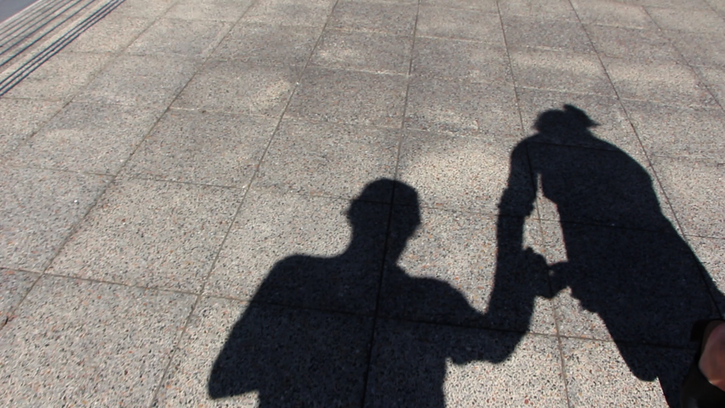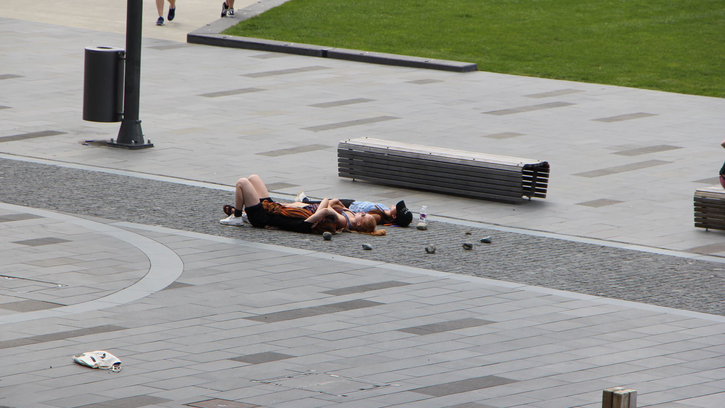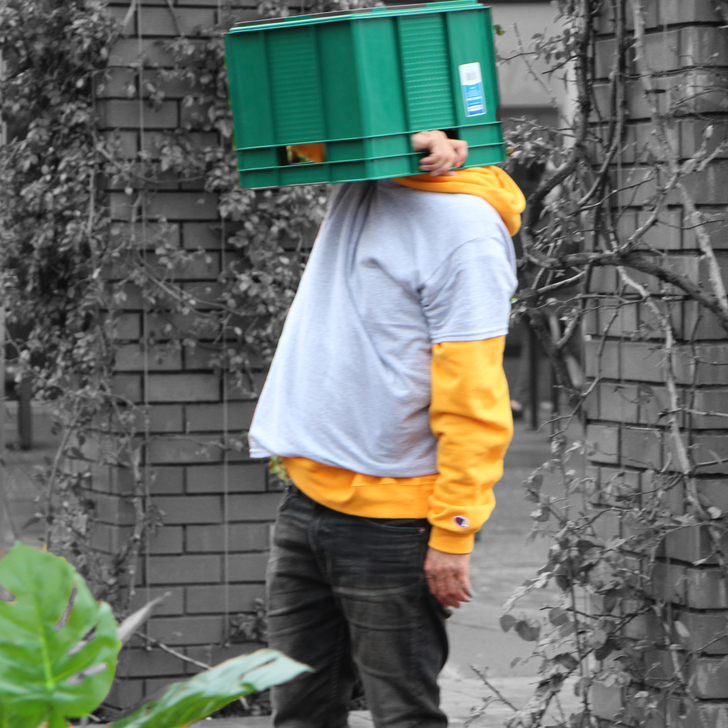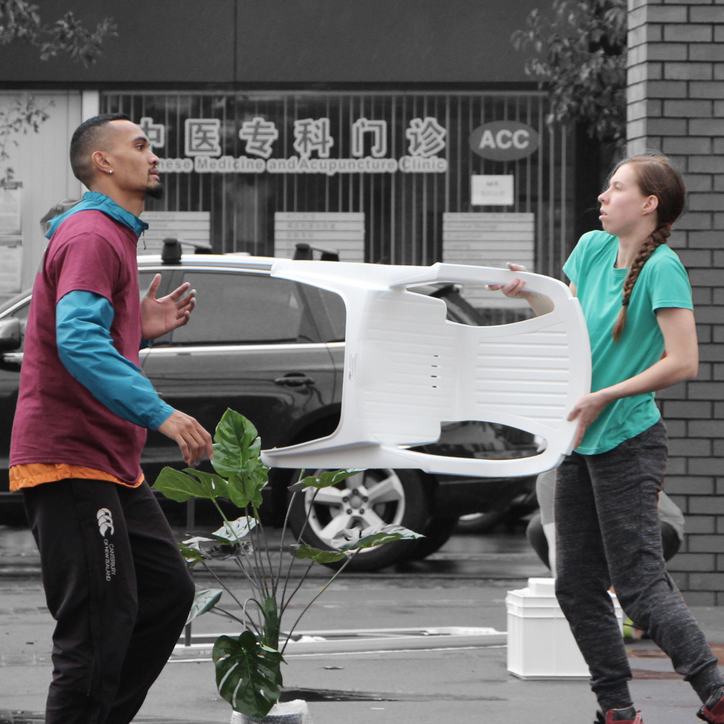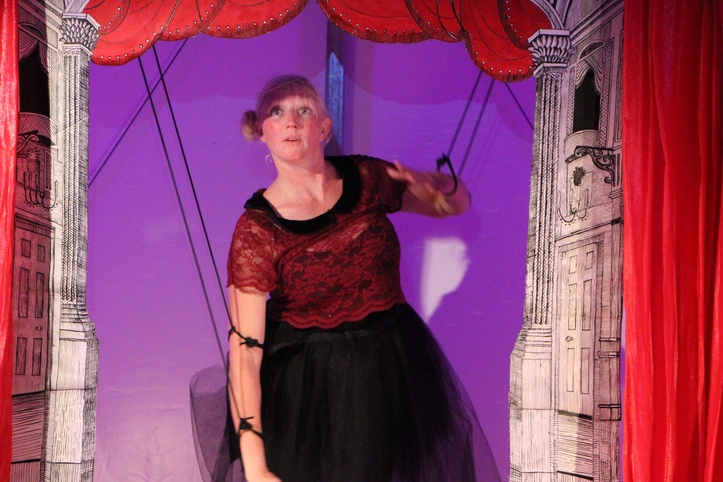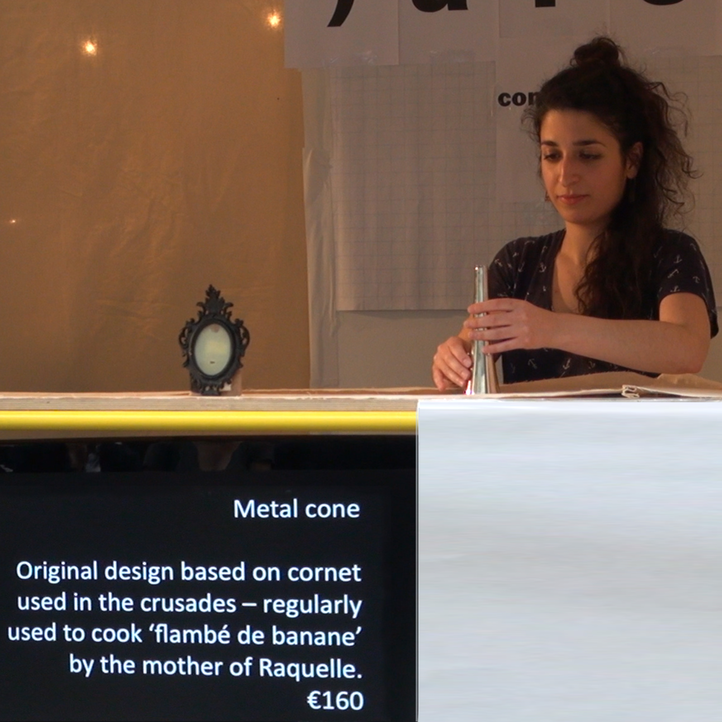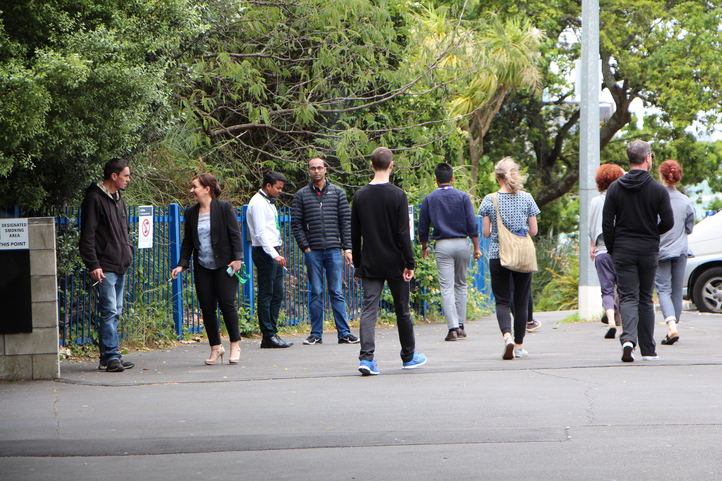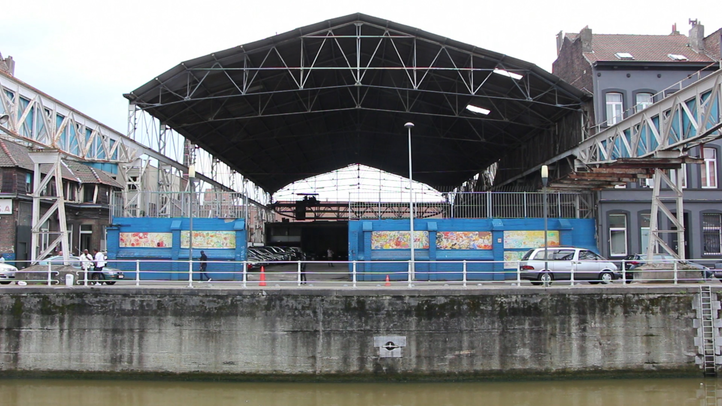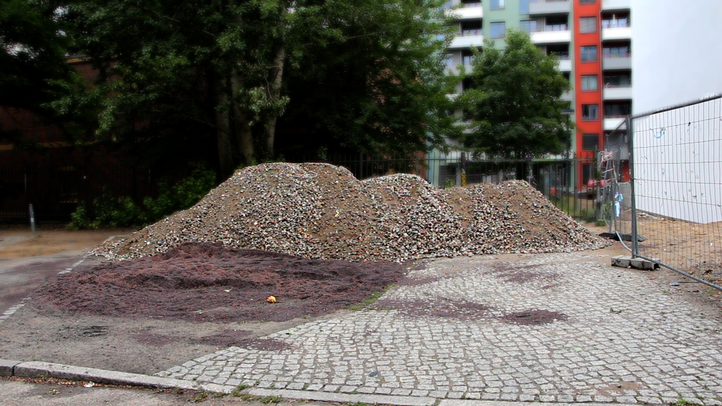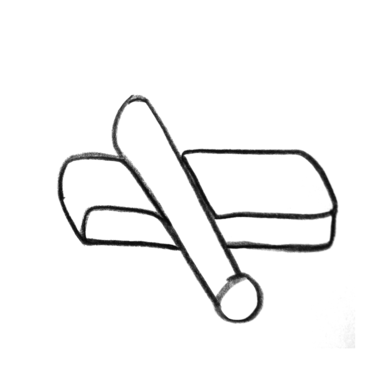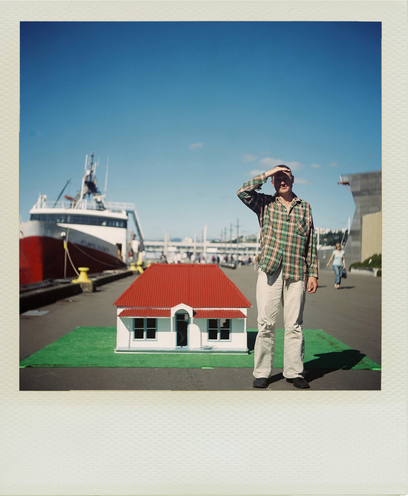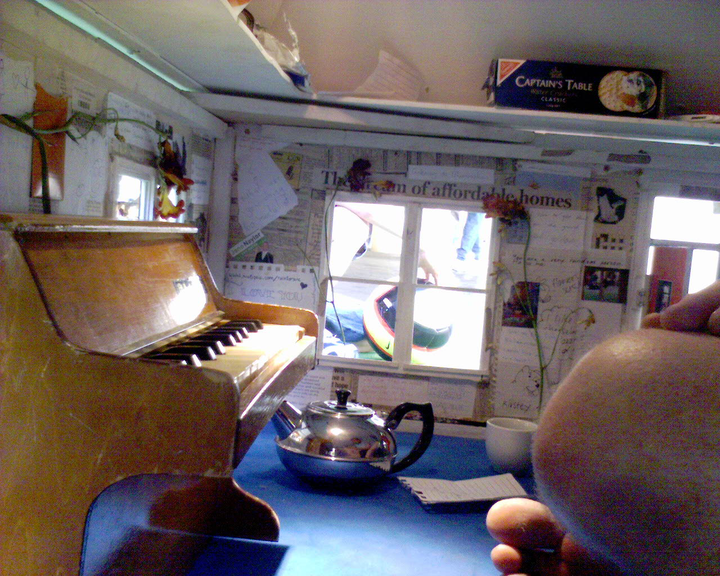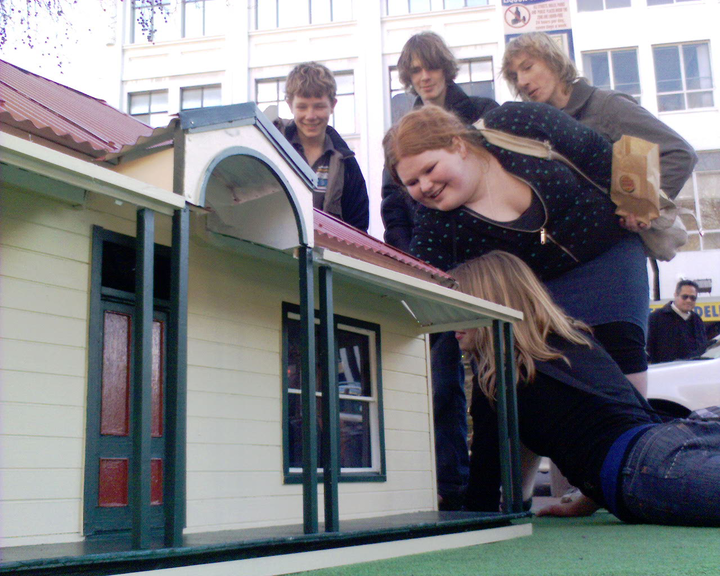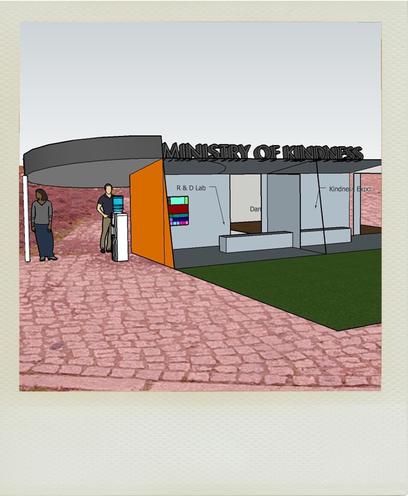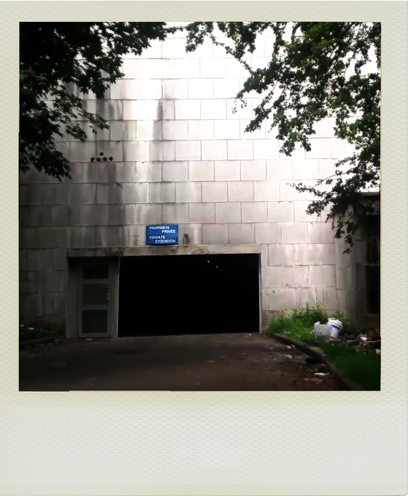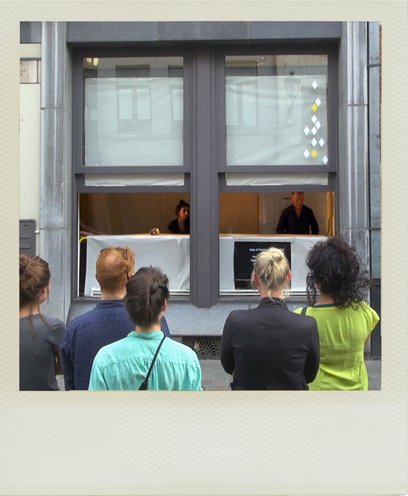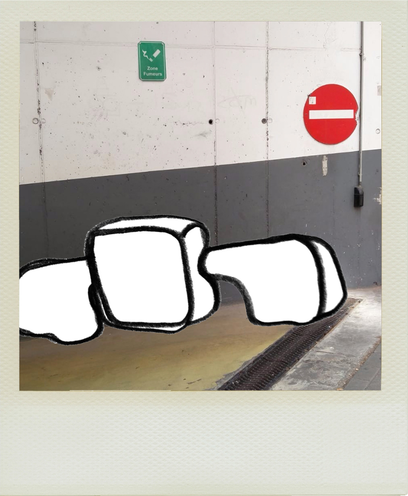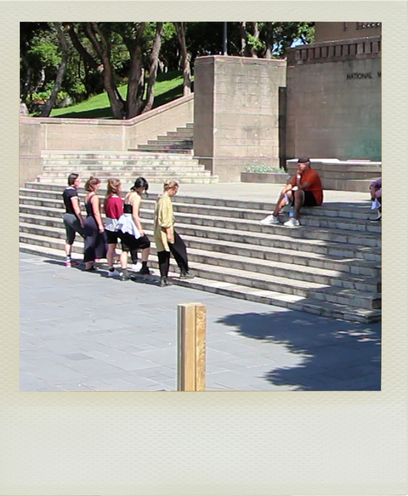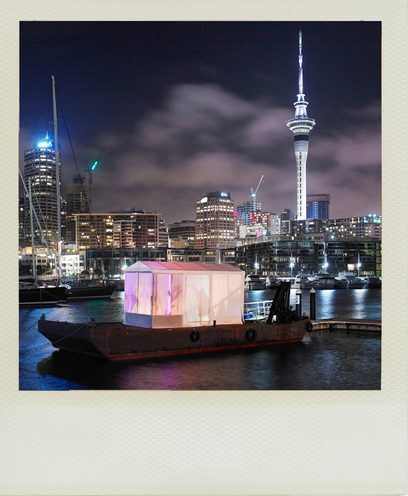Extra Ordinary Folk
Location
Context
Collaboration
Form
Materials
Strategy
Description
This choreographic group-performance transposes fields of everyday movement onto public space in order to reveal social dynamics. A transitional space in West Auckland links a large suburban mall to a public transport hub, and is occupied by a war memorial that uses the language and scale of civic architecture (standardised materials - bricks, multi-functional, classical proportions) to increase accessibility and add aesthetic qualities. This spatially charged location was negotiated by the local community arts board as the site for a choreography with 7 dancers. In order to further clutter the space we brought a number of mass-produced consumer items sourced from nearby hardware stores; a table, storage boxes, folding chairs, a plastic pot-plant, in order to signify the domestic domain within the civic.
The improvisation structure was developed by choreographer Claire O’Neil in the dance studio, using a vocabulary of daily movements from domestic and vocational settings. Each performer inhabited a ‘habitus’, a term derived from sociologist Pierre Bourdieu bringing together social, physical and economic spheres (Bourdieu 1977), eventually encroaching on each other’s space and individualising the public architecture. The objects helped externalise the interference between individuals, and allowed a larger more porous sphere of influence on the performance. Masking tape on the ground was laid out during the performance and used to help define individual fields, to segregate some behaviours from others, and to undermine the civic authority of the public architecture (including the war memorial).
A pre-learned folk dance, created by the group and incorporating domestic chores, expressions of care and self-preservation, was used structurally to bring the performance into a unison crescendo, and also invited the public in to participate. Live and pre-recorded music was used to influence the choreography and add a manipulation of time. The performance was around 30 mins duration and repeated twice at the same location.
Discussion
Extra Ordinary Folk was a choreographic response to a deconstruction of social dynamics, using the definitions derived by Pierre Bourdieu throughout his career. A ‘habitus’ was individually interpreted by each performer, bringing together ‘social fields’ of practice or play, and relational ‘capital’, which may be economic, cultural, social or symbolic (Bourdieu, 1989). The public, who were simultaneously passing through the performers' social field, could be said to embody their own habitus. This was acknowledged by the performers through playful and affecting exchanges. External elements such as the architecture and the weather, were also acknowledged through the use of the objects, constantly disrupting and re-negotiating the space. Public space in this case, was a location for private expression, creating collective social dynamics.
Bourdieu, P. (1977). Outline of a Theory of Practice, Cambridge university press.
Bourdieu, P. (1989). "Social space and symbolic power." Sociological theory 7(1): 14-25.
Margins & Boarderlines
Location
Context
Collaboration
Form
Materials
Strategy
Description
A simple choreographic operation in public space. A group of performers follow each other walking in single file, following visual lines that border one space from another. The borders are either textural (the grass where it borders the concrete, where the stone turns to asphalt, where the shadow of the trees begin) or implied through the geography (a line of bollards or following the underground road). By moving in unison, the group reveal the many borders that coexist in this space, they also highlight the continuation of borders from the city that are pulled into this space. The perimeters of public space are revealed to be porous, subjective, continuous, extendible.
The newly finished Pukeahu Park in central Wellington, New Zealand, is a carefully designed public space allowing pedestrians multiple lines of transit as well as spaces that are contemplative or formal. Two war memorial structures (made almost 80 years apart) dissect the space, which is typically vulnerable to Wellington’s harsh windy weather.
Discussion
Considering aspects of Lefebvre’s Production of Space, where a critical analysis of urban space is also understood in the context of everyday life, choreographic operations attempt to embody spatial relationships (Lefebvre, 1991). In this performance experiment the periphery is considered in relation to the centre in a purely physical expression, however the political implications are also discussed, putting forward developments to the experiment to break the group into parts in order to counterpoint the relationships.
Lefebvre, H. (1991). The production of space, Oxford Blackwell.
Baby, where are the fine things you promised me?
Location
Context
Collaboration
Form
Materials
Strategy
Description
Baby, where are the fine things you promised me? is a mobile performance structure, inside of which the artists lives his normal domestic routines for the course of a day, situated in unlikely urban environments. The model of a Victorian cottage fictionalises a true history (a model of the artist's previously rented home), and allows the public to interact via the ground level windows to the occupant, sharing daily domestic conversation, drinking tea, or sharing music. Placed in busy urban spaces where domestic architecture is largely absent, the little house becomes a beacon symbol of home that elicits public involvement and spontaneous response. Written or drawn notes, either passed through the windows or posted anonymously into the letterbox, play an important role in proximity, allowing different levels of engagement and allowing some distance within a very intimate setting.
The Victorian colonial cottage is historically significant in post-colonial Aotearoa:New Zealand. Many thousands of these houses were built during the late 19th and early 20th century migration of European populations. The individually owned houses typically sat on a quarter acre block of land, and represented the new-world values of egalitarian ownership of resources and affordable domestic lifestyles. In the competitive economic environment of the 21st century these values are no longer accessible to many, leaving the symbol of a lost promise.
Discussion
Literary critic Susan Stewart refers to the miniature as it ‘represents closure, interiority, the domestic’ (1984, P.70), comparatively turning the public into giants. In order to speak with the artist, the public had to lie down on the ground, an act of performance in itself since it changes the relationship to the street and to the public, a dramatic inversion of hierarchies.
The symbolic home, domestic ritual and intimacy, are forced by miniaturisation to find new meaning in the public realm of the city street, just as the political dimension of inequality is played out by transient populations and poverty stricken people sleeping in the sheltered entranceways to luxury stores. The gigantic human inside the miniature house is a distortion that physically moves the public onto the ground, onto all fours, touching the domestic promise made by previous generations and not passed on.
Stewart, S. (1984). On longing: Narratives of the miniature, the gigantic, the souvenir, the collection, Duke University Press.
Reverse Dollar Exchange (Planned Performance)
Location
Context
Collaboration
Form
Materials
Strategy
Description
The Reverse Dollar Exchange is a commodity exchange for one dollar, the simplest unit of finance and standard measure of value. The Reverse Dollar Exchange is a temporary booth, using the language of commerce, where the public are invited to exchange anything at all for $1. No restrictions are placed on what may be exchanged, it may be a physical object, a service, an action, or an intangible concept, the booth will give one dollar to each person for absolutely anything. Some documentation is taken, either with an image, the written word or an object, and this is displayed in a makeshift vitrine (placed inside standardised zip-lock plastic bags). On a surface level the booth produces a graphic representation of the use-value of one dollar, with comparative difference between socio-economic locations within the city. Supporting this reading however, is a playful manipulation of the terms of economic exchange, provoking the public to situate themselves relative to the power dynamics of financial trade.
The Reverse Dollar Exchange will begin as one part of a three day event planned for the end of 2018 in Auckland, called The Ministry of Kindness. This fictional ministry parodies government agencies to present empathy as a meaningful strategy for fulfilment, riffing on the language of economic development used by neoliberal government agencies. Inspired by a radio interview with the incoming Prime Minister Jacinda Adern in October 2017, the Labour-coalition leader declared that the she wanted the government ‘to bring kindness back’[i].
Discussion
The Reverse Dollar Exchange inverts the power relationship of financial exchange, where use-value or exchange-value are relative to labour (over time). There are three expected responses to these exchanges between the payer (myself) and the payee (the public).
1 - The public is left to guess what the desire of the payer might be, what they choose to give as exchange is essentially guessing their desires.
2 - The payee considers what one dollar might be worth to themselves, including the worth of labour in the face-to-face exchange, or an altruistic desire for the artist to get a good bargain, or be seen as a generous person.
3 - The artist is seen as a naive sucker, who will part with $1 in exchange for something of no value to the payee, proving to be a justified exploitation.
Breeding Monsters (Planning)
Location
Context
Collaboration
Form
Materials
Strategy
Description
The urban environment is full of spaces that either change function with a shifting social or economic fortunes, or that fail to be useful through negligence, misfortune or disaster. These space are often referred to as uncanny, since they are both familiar and unknown. Breeding Monsters uncovers the mask of the uncanny by giving a clear form and presence in the guise of a monster. Collecting field recordings from the human and the non-human world, and through choreographic interventions together with materials of mass production (plastic, construction debris, logistics boxing), the monstrous is evoked literally, inhabiting the space with as the fictional residue of absence. The monsters embody and inhabit the spaces, filling the void that created them. The second part of the performance relocates the fictional monster into highly visible commonplace spaces, (street corners, malls, carparks, gardens) inverting the relationship between context and presence.
Working across two cities, (where we are currently living) the collaboration makes use of familiar and unfamiliar environments, giving instructions of choreographic operations to one another in turn, then rehousing the monster in a different context. Structured as a set of studies, drawing on our 6 year common studio practice, this project mixes symbolic meaning with shared cultural references.
Discussion
The monstrous is frequently associated with disaster, both in literature and in folk-lore, which philosophers Jane and Lewis Gordon consider as ‘creatures of admonition’ (Gordon & Gordon 2015). When something does terribly wrong, the residue of that memory becomes monstrous, both in a psychological sense but also in the material environment. Environmental disasters such as radioactive poisoning in Fukushima and Chernobyl, or the oil spill in the Gulf of Mexico, all produce monstrous residue materially and psychically. As liberal democratic cities move industry out from the population centres, monstrous spaces that housed enormous machines are repurposed, with art interventions frequently used for their transformative power to discharge or recharge spaces of their residue.
Gordon, JA & Gordon, LR 2015, Of divine warning: Disaster in a modern age, Routledge.
ARS concepts
Location
Context
Collaborators
Form
Materials
Strategy
Description
ARS concepts is a parody on authenticity as commodity, particularly within ‘hipster’ culture, which rejects objects of mass production in favour of a return to the hand made. ARS concepts (a cynical acronym for its three fictional entrepreneurial developers Ashilen, Raquelle, Stephane), turn an emptied café shop window into a specialist repurposed collectables store. In recognition of iconic rue de Flandres in central Brussels, which boasts an array of new or repurposed artisanal-styled products from hand-knitted woollen clothing to rare second-hand vinyl, ARS Concepts takes repurposing to an absurd extreme. All items are literally bought from local residents of the street during a community flea-market (coincidentally a few days before the performance) then repackaged as ARS-Authentic and revalued for sale online and offline.
A low-tech parody of hi-tech marketing uses an automated conveyer belt, similar to a sushi train, with each product simultaneously described for authenticity on a computer screen. The descriptions are exaggerated claims that included local celebrities, heart-wrenching love stories, tragedies, tenuous connections and bizarre claims.
“Picture frame from the bathroom of Fleur-Marie, a talented painter who never realised her dreams. €110”
“Miniature Trees. Gift from a drug dealer to his client for years of loyalty €94”
The objects use white-space aesthetics to fetishize the objects and create value, in an attempt to create an elite experience. The ten minute performance plays several times as a loop, using amiable sound and light to enhance the aesthetic haze. Objects bought for a euro or two were revalued at up to 300 Euros. No sales were made.
Discussion
ARS concepts acknowledges how current fashion-cultures value authenticity. ‘Hipster’ culture is a recent social phenomena, which sociologist Bjørn Schiermer associates to a ‘redemptive gesture toward the objects of the recent past and its predilection for irony’ (Schiermer 2014, P. 167). The performance also recognises how the arts are frequently instrumental in urban transformation, or gentrification, as identified by urban planners and sociologists such as Ali Cheshmehzangi within the development and (re)organisation of space (Cheshmehzangi 2016). Within a globalized network economy, the ARS Concept (ironically close to ARSE - as in “what a load of arse”) preaches acting locally as a valued commodity, yet actively employs outsourcing and globalized marketing strategies - as exemplified by the online trans-national trading. The aesthetic is also highly reflective of the ‘experience economy’ as originally stated in financial terms by economists Pine & Gilmore (1995), and discussed to some degree within the performing arts sphere by performance theorist Claire Bishop (Bishop 2012) in terms of its exchange to labour value. However, it is the visual arts theorist Dorotea von Hantelmann who begins to articulate this new ‘experiential turn’ as a relationship between a remote access to material production and subjective experience. If ‘Western societies are on their way to a postindustrial social order, this development [the experiential turn] is mirrored in art’s shift from the object towards the dimensions of subjective and intersubjective experience.’(Von Hantelmann 2014)
Schiermer, B. (2014). "Late-modern hipsters: New tendencies in popular culture." Acta Sociologica 57(2): 167-181.
Cheshmehzangi, A. (2016). "Temporary and temporality: Public realm regeneration through temporary events." Journal of Urban Regeneration & Renewal 10(1): 58-72.
Pine, I. I. B. J. and J. H. Gilmore (1998). "WELCOME TO THE EXPERIENCE ECONOMY." Harvard Business Review 76(4): 97-105.
Bishop, C. (2012). Artificial hells: Participatory art and the politics of spectatorship, Verso Books.
Harvie, J. (2013). Fair Play-Art, Performance and Neoliberalism, Springer.
McKenzie, J. (2008). "Global feeling." Performance Design: 113-128.
Von Hantelmann, D 2014, 'The Experiential Turn', Living Collections Catalogue, viewed 10 June 2018, <http://www.walkerart.org/collections/publications/performativity/>.
The Floating Theatre (test season)
Location
Context
Collaboration
Form
Materials
Strategy
Description
The Floating Theatre is a mobile structure that floats on a barge. Assembled from custom-made steel frame, wooden scaffolding planks and a white PVC skin, the fully functioning theatre seats 30 people. The theatre arrives during the day via the sea and stays moored up to a marina or jetty for the duration of its season. When the theatre is inhabited by the audience during a performance, the interior lighting throws shadows and light projection onto the white walls, exposing all the mechanisms of the theatrical performance and the audience themselves.
The performance is made specifically for the theatre, and was conceived around a theatrical device of trapdoors in the stage allowing the two performers to endlessly appear and disappear. The performance itself is loosely inspired by Herman Hesse’s Steppenwolf, whereby a ‘magic theatre’ is the central metaphor for a psychological and spiritual crisis of its central protagonist. The performance in The Floating Theatre uses 19th century theatrical tropes to highlight the representation of illusion as a machine, exposing the mechanisms to the audience rather than obscuring them.
Discussion
The Floating Theatre floats on water as a dream-space, unable to be quantified or fully rationalised since it evades permanence. It is evocative of philosopher Michael Foucault’s ‘heterotopian’ space, that is ‘capable of juxtaposing in a single real place several spaces, several sites that are in themselves incompatible (Foucault 1986, P.6).’
Architect Aldo Rossi, whose floating theatre pavilion Teatro del Mondo in the 1979 Venice Biennale was a miniaturisation of the monumental Venitean architecture, later explored ideas of the ‘analogous city’, which ultimately ‘concerns the collective imagination... a synthesis of a series of values’ (as cited in Hays 2008, P.117).
Foucault, M. and J. Miskowiec (1986). "Of other spaces." diacritics 16(1): 22-27.
Hays, K. M. (2008). "The desire called architecture."
Smokers’ Ground
Location
Context
Collaboration
Form
Materials
Strategy
Description
Smokers’ Ground is a spatial intervention exploring the exclusionary status of designated smoker’s space. Inflatable structures of varying scale and ambiguity are used as fetishist furniture, which simultaneously become temporary boundaries between smoking and non-smoking social spaces. The objects use an aesthetics of inclusion and tactile participation, to enact the overtly divisive function of excluding smokers from public space. The proposed choreographic intervention uses the context of an arts festival social space (an habitually liberal social grouping), where an open-air bar and restaurant incorporate provocative ways to exercise exclusion. Daily interventions evolve the space toward and away from the boundaries, resolving and testing the boundaries of inclusion and exclusion within a morally segregated group.
Drawing on relatively new legislation (in the last 10 years) that segregates space disproportionately between smokers and non-smokers, access to space is closely linked to morality and the hierarchy of legality. Smokers’ Ground uses the familiar environment of social smoking divisions to reflect on moral rigidity, the legality of exclusion on ethical grounds, and the appropriation of space from the social minority. The intervention plans to distort and reverse the appropriation of space over time (2 weeks), giving unjustified privilege to the morally indefensible smokers, provoking discussion and encouraging acts of subversion.
Discussion
Smokers’ Ground tests the principles of public space under the artificial pressures of a temporary space. Geographer Peter Marcuse offers five principles described as - equity in distribution of resources, accessibility, non-exclusionary access, aesthetic quality, and environmental sustainability (Marcuse 2003), each of which is actively violated over the course of intervention. The tools of division, large tactile inflatable plastic objects, are frequently associated with the architecture of democratic subversion. Avant-garde American architectural group Ant Farm’s self-published manual Inflatocookbook in (Ant Farm 1971) used various permutations of this throughout their work from 1970s to the early 2000s. Cheaply constructed inflatables have been used by contemporary artists such as Artúr van Balen in Tools for Action, where objects of resistance are democratically sourced and manipulated as a practical tool for activism serve as a means to resolve tense and potentially violent moments (Malzacher 2014, P.15).
These alternative, temporary architectures are essentially a reaction to permanence, one in which German cultural philosopher Peter Sloterdijk reminds us that ‘architecture is inherently a form of totalitarianism… because it is concerned with immersion, that is, with the production of an environment into which its inhabitants submerge, body and all (Sloterdijk 2011).’
Farm, A. (1971). Inflatocookbook. Sausalito, CA: Rip Off Press.
Malzacher, F. (2014). Truth is Concrete. A Handbook for Artistic Strategies in Real Politics, Sternberg Press.
Sloterdijk, P. (2011). "Architecture As an Art of Immersion (2006)(translated by A.-Chr. Engels-Schwarzpaul)." Interstices: Journal of Architecture
- Berlin, DE & Brussels BE
- ongoing etudes
- Joshua Rutter (collaborator and co-performer)
- Choreographic and sound intervention
- Found spaces,
- Fiction as Residue
- Pukeaha National War Memorial Park, Wellington, New Zealand
- choreographic Workshop
- choreographer Kate McIntosh together with students of Choreolab 18, (Footnote Dance Company Summer School)
- performance experiment / Choreographic intervention
- bodies in Space
- fiction as transposition
- Designated smoking area
- Public smoking spaces (festival proposal)
- Joshua Rutter (NZ/DE)
- Choreographic Intervention
- Inflatable objects, chairs, ash trays
- fiction as resistance
- various locations, throughout Aotearoa: New Zealand
- independent street interventions & Arts festivals
- solo
- performance Installation
- wooden cottage 1:8 scale, artificial grass, domestic objects
- fiction as Mythology
- rue de Flandres, Brussels, Belgium
- workshop on public performance by Antonio Pensotti (AG)
- Mahshid Dastgheib (IR/FR), Zoe Ni Riordain (IRL)
- installation performance
- paper, powerpoint video, objects from community market day
- fiction as parody
- War Memorial, New Lynn Shopping Mall, Auckland
- Public Performance
- Fieldwork Collective, Choreographer: Claire O’Neil, Producer: Sarah-Louise Collins, DJ: Kristian Larsen, Performers: Solomon Holly-Massey, Rose Tapsell, Aloalii Tapu, Tallulah Holly-Massey, Claire O’Neil, Stephen Bain
- Choreographic Performance
- Plastic chairs, plastic storage boxes, plastic table
- Fiction as possible worlds
- viaduct Marina & Whau River, AUCKLAND
- advertised performance event, part of Fringe Festival
- designed, directed & produced by Stephen Bain
Performers: Jeremy Randerson & Jenny McArthur, Music: Jeff Henderson, Costumes: Sarah-Jane Blake, Lights: Sean Curham, Construction: Showquip, Metalmen, Fabric Structures, Dramaturgy: John Downie
- theatrical performance
- barge, steel frame structure with wooden interior and PVC outer skin
- fiction as value creation

